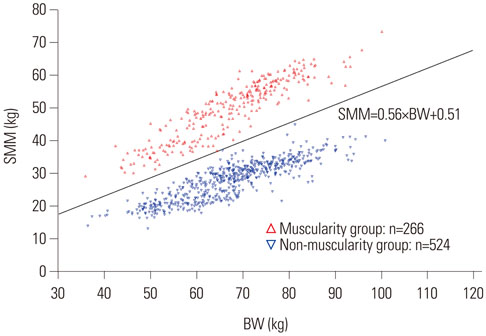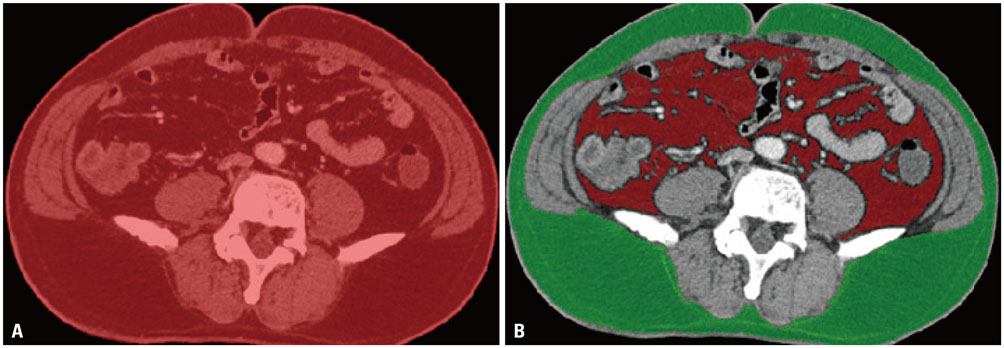Yonsei Med J.
2018 Jun;59(4):546-553. 10.3349/ymj.2018.59.4.546.
Estimation of Standard Liver Volume Using CT Volume, Body Composition, and Abdominal Geometry Measurements
- Affiliations
-
- 1Department of Industrial and Management Engineering, Pohang University of Science and Technology, Pohang, Korea. hcyou@postech.ac.kr
- 2Department of Surgery, Chonbuk National University Medical School, Jeonju, Korea. hcyu@jbnu.ac.kr
- 3Research Institute of Clinical Medicine of Chonbuk National University-Biomedical Research Institute of Chonbuk University Hospital, Jeonju, Korea.
- 4Research Institute for Endocrine Sciences, Chonbuk National University, Jeonju, Korea.
- KMID: 2410910
- DOI: http://doi.org/10.3349/ymj.2018.59.4.546
Abstract
- PURPOSE
The present study developed formulas for estimation of standard liver volume (SLV) with high accuracy for the Korean population.
MATERIALS AND METHODS
SLV estimation formulas were established using gender-balanced and gender-unbalanced measurements of anthropometric variables, body composition variables, and abdominal geometry of healthy Koreans (n=790). Total liver volume excluding blood volume, was measured based on CT volumetry.
RESULTS
SLV estimation formulas as preferred in various conditions of data availability were suggested in the present study. The suggested SLV estimation formulas in the present study were found superior to existing formulas, with an increased accuracy of 4.0-217.5 mL for absolute error and 0.2-18.7% for percentage of absolute error.
CONCLUSION
SLV estimation formulas using gender-balanced measurements showed better performance than those using gender-unbalanced measurements. Inclusion of body composition and abdominal geometry variables contributed to improved performance of SLV estimation.
Keyword
MeSH Terms
Figure
Cited by 1 articles
-
A new formula for estimation of standard liver volume using liver height and thoracic width
Xiaopeng Yang, Mi Rin Lee, Jae Do Yang
Ann Surg Treat Res. 2022;103(1):47-52. doi: 10.4174/astr.2022.103.1.47.
Reference
-
1. Kawasaki S, Makuuchi M, Matsunami H, Hashikura Y, Ikegami T, Nakazawa Y, et al. Living related liver transplantation in adults. Ann Surg. 1998; 227(2):269–274.
Article2. Chen CL, Fan ST, Lee SG, Makuuchi M, Tanaka K. Living donor liver transplantation: 12 years of experience in Asia. Transplantation. 2003; 75:Suppl 3. 6–11.3. Lo CM, Fan ST, Liu CL, Chan JK, Lam BK, Lau GK, et al. Minimum graft size for successful living donor liver transplantation. Transplantation. 1999; 68(8):1112–1116.
Article4. Inomata Y, Kiuchi T, Kim I, Uemoto S, Egawa H, Asonuma K, et al. Auxiliary partial orthotopic living donor liver transplantation as an aid for small-for-size graft in larger recipients. Transplantation. 1999; 67(10):1314–1319.
Article5. Sakamoto S, Uemoto S, Uryuhara K, Kim I, Kiuchi T, Egawa H, et al. Graft size assessment and analysis of donors for living donor liver transplantation using right lobe. Transplantation. 2001; 71:1407–1413.
Article6. Kiuchi T, Kasahara M, Uryuhara K, Inomata Y, Uemoto Y, Asonuma K, et al. Impact of graft size mismatching on graft prognosis in liver transplantation from living donors. Transplantation. 1999; 67:321–327.
Article7. Ben-Haim M, Emre S, Fishbein TM, Sheiner PA, Bodian CA, Kim-Schluger L, et al. Critical graft size in adult-toadult living donor liver transplantation: impact of the recipient's disease. Liver Transpl. 2001; 7:948–953.
Article8. Heaton N. Small-for-size liver syndrome after auxiliary and split liver transplantation: donor selection. Liver Transpl. 2003; 9(9):S26–S28.
Article9. Kiuchi T, Tanaka K, Ito T, Oike F, Ogura Y, Fujimoto Y, et al. Small-for-size graft in living donor liver transplantation: how far should we go? Liver Transpl. 2003; 9:S29–S35.
Article10. Nishizaki T, Ikegami T, Hiroshige S, Hashimoto K, Uchiyama H, Yoshizumi T, et al. Small graft for living donor liver transplantation. Ann Surg. 2001; 233:575–580.
Article11. Sugawara Y, Makuuchi M, Takayama T, Imamura H, Dowaki S, Mizuta K, et al. Small-for-size grafts in living-related liver transplantation. J Am Coll Surg. 2001; 192:510–513.
Article12. Levesque E, Duclos J, Ciacio O, Adam R, Castaing D, Vibert E. Influence of larger graft weight to recipient weight on the post-liver transplantation course. Clin Transplant. 2013; 27:239–247.
Article13. Urata K, Kawasaki S, Matsunami H, Hashikura Y, Ikegami T, Ishizone S, et al. Calculation of child and adult standard liver volume for liver transplantation. Hepatology. 1995; 21:1317–1321.
Article14. Heinemann A, Wischhusen F, Püschel K, Rogiers X. Standard liver volume in the Caucasian population. Liver Transpl Surg. 1999; 5:366–368.
Article15. Vauthey JN, Abdalla EK, Doherty DA, Gertsch P, Fenstermacher MJ, Loyer EM, et al. Body surface area and body weight predict total liver volume in Western adults. Liver Transpl. 2002; 8:233–240.
Article16. Hashimoto T, Makuuchi M. Transplantation: liver steatosis and errors in estimation of standard liver volume. Nat Rev Gastroenterol Hepatol. 2011; 8:667–668.
Article17. Yu HC, You H, Lee H, Jin ZW, Moon JI, Cho BH. Estimation of standard liver volume for liver transplantation in the Korean population. Liver Transpl. 2004; 10:779–783.
Article18. Yuan D, Lu T, Wei YG, Li B, Yan LN, Zeng Y, et al. Estimation of standard liver volume for liver transplantation in the Chinese population. Transplant Proc. 2008; 40:3536–3540.
Article19. Fu-Gui L, Lu-Nan Y, Bo L, Yong Z, Tian-Fu W, Ming-Qing X, et al. Estimation of standard liver volume in Chinese adult living donors. Transplant Proc. 2009; 41:4052–4056.
Article20. Poovathumkadavil A, Leung KF, Al Ghamdi HM, El Hassan Othman I, Meshikhes AW. Standard formula for liver volume in Middle Eastern Arabic adults. Transplant Proc. 2010; 42:3600–3605.
Article21. Kokudo T, Hasegawa K, Uldry E, Matsuyama Y, Kaneko J, Akamatsu N, et al. A new formula for calculating standard liver volume for living donor liver transplantation without using body weight. J Hepatol. 2015; 63:848–854.
Article22. Um EH, Hwang S, Song GW, Jung DH, Ahn CS, Kim KH, et al. Calculation of standard liver volume in Korean adults with analysis of confounding variables. Korean J Hepatobiliary Pancreat Surg. 2015; 19:133–138.
Article23. Cortes C, Vapnik V. Support-vector networks. Machine Learning. 1995; 20:273–297.
Article24. Du Bois D, Du Bois EF. A formula to estimate the approximate surface area if height and weight be known. Nutrition. 1989; 5:303–311.25. Yang X, Yu HC, Choi Y, Lee W, Wang B, Yang J, et al. A hybrid semiautomatic method for liver segmentation based on level-set methods using multiple seed points. Comput Methods Programs Biomed. 2014; 113:69–79.
Article26. Heymsfield SB, Fulenwider T, Nordlinger B, Barlow R, Sones P, Kutner M. Accurate measurement of liver, kidney, and spleen volume and mass by computerized axial tomography. Ann Intern Med. 1979; 90:185–187.
Article27. Nolden M, Zelzer S, Seitel A, Wald D, Mller M, Franz A, et al. The medical imaging interaction toolkit: challenges and advances. Int J Comput Assist Radiol Surg. 2013; 8:607–620.
Article28. Ibáñez L, Schroeder W, Ng L, Cates J. The ITK software guide. 2nd ed. Clifton Park (NY): Kitware, Inc.;2005.29. Pomposelli JJ, Tongyoo A, Wald C, Pomfret EA. ariability of standard liver volume estimation versus software-assisted total liver volume measurement. Liver Transpl. 2012; 18:1083–1092.
Article30. Yang X, Chu CW, Yang JD, Yang KH, Yu HC, Cho BH, et al. Estimation of right-lobe graft weight from computed tomographic volumetry for living donor liver transplantation. Transplant Proc. 2017; 49:303–308.
Article
- Full Text Links
- Actions
-
Cited
- CITED
-
- Close
- Share
- Similar articles
-
- Calculation of Standard Liver Volume of Korean Adults
- A new formula for estimation of standard liver volume using liver height and thoracic width
- Preoperative estimation of hemi-liver volume using standard liver volume and portal vein diameter ratio in living donor liver transplantation
- Quantification of Pneumothorax Volume on Chest Radiographs: Comparison between the Collins' and the Axel's Methods with
- Clinical usefulness of bioimpedance analysis for assessing volume status in patients receiving maintenance dialysis




